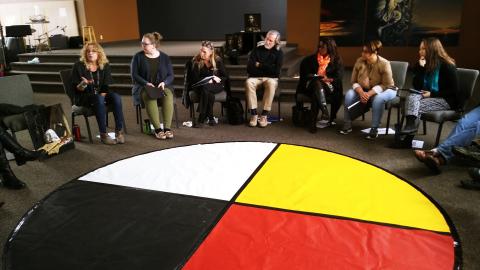Gentrification and Learning Our Common History in Canada (Race Relations US-Midwest Newsletter)

This is a portion of Viviana's April newsletter. To receive the full version of her newsletters every other month, sign up below!
I had the blessing of going to Canada twice in these last couple of weeks. Near the end of March, I spent a weekend with people who had decided not to be silent about injustices in the past and present against Indigenous peoples in the northern part of Turtle Island (Canada). They were gathered to be trained as facilitators of the Blanket Exercise. Staff from KAIROS, the organization that started this exercise, were also present and they shared many of their experiences. As a part of the training, we participated in a KAIROS Blanket Exercise. An Indigenous elder was present to lead us in a smudge and teach us about her customs and traditions.
As we prepared to return on Sunday, we had the joy of worshipping with Meadowlands Fellowship CRC in Mississauga and receiving the blessings and prayers of pastor Sam Cooper and other brothers and sisters of the congregation. We finished our time by visiting the Six Nations of the Grand River (a Haudenosaunee reserve), and a former residential school in Brantford that closed in 1970. It was a weekend of learning, listening, and receiving blessings.
A couple of weeks later, I returned to Canada, this time to Toronto where our friend and colleague Bernadette had prepared some learning activities for us. We had lunch at the Pow-Wow Café, a restaurant owned by an Ojibway chef, and we enjoyed some delicious fry bread tacos. We visited the Native Canadian Center (http://ncct.on.ca/) where we had some good conversation with a staff member. Later we visited an incredible bookstore called A Different Booklist to learn about the history of Black Canadians, something that not many people know about. The area around Dundas Street and University Avenue was once an immigrant neighborhood “the Ward”, or St. John’s Ward. Now it’s being “renovated” — old buildings have been torn down to build new and modern buildings. In the excavations, they’ve been finding some artifacts and belongings of the people who live there, like Cecelia Jane Reynolds, a former slave. You can find her story in this Toronto Star article.
When I saw the picture; I thought, “How easy it is to get rid of history.” How many lives, stories, joys, and suffering were part of buildings that no longer exist and are being replaced by new structures.
Gentrification is a force that kills the past without recognizing the history behind and the learning we can gain from it. (See Pastor John Eigege’s article to learn more about how gentrification is undoing history in his neighborhood in Houston.) Gentrification is relocation, a practice that began in the 1800’s. In Grand Rapids, MI, the Anishinaabeg people where the first ones to be displaced.
Our friend Bernadette also invited us to experience a new workshop prepared by her and another colleague. It is about the importance of listening to others’ narratives to have a full sense of our history and, in the words of George Erasmus, to develop “a common memory.”
As I mentioned before, these trips were trips of learning and listening. I didn’t know much about the history of Canada, just a few things here and there. I learned that Canada’s history isn’t much different from the United States’ history. Many of the laws that were put in place here in U.S. were also legislated in Canada — not just towards Indigenous people, but also towards Blacks, Asians, and Latinos.
Racial Reconciliation, Multicultural
Racial Reconciliation
Racial Reconciliation, Ministry in Canada
Connect to The Network and add your own question, blog, resource, or job.
Add Your Post
Let's Discuss
We love your comments! Thank you for helping us uphold the Community Guidelines to make this an encouraging and respectful community for everyone.